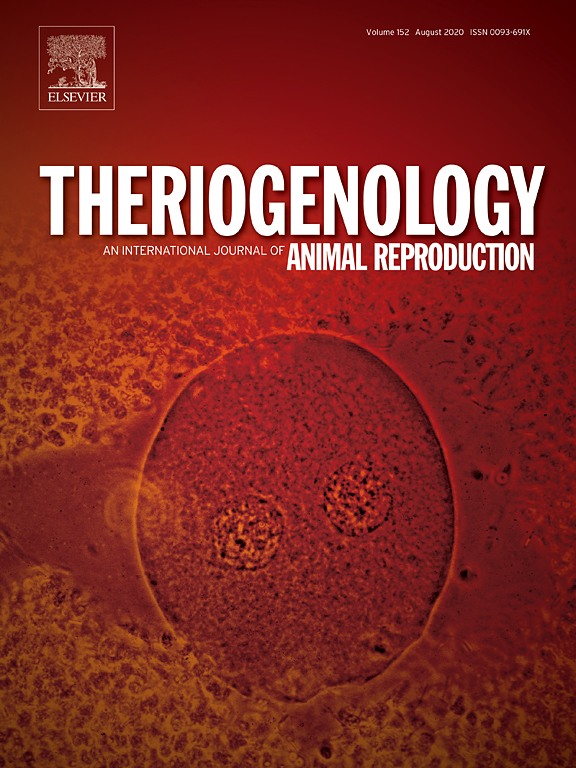Ver ítem
- xmlui.general.dspace_homeCentros Regionales y EEAsCentro Regional Patagonia NorteEEA BarilocheArtículos científicosxmlui.ArtifactBrowser.ItemViewer.trail
- Inicio
- Centros Regionales y EEAs
- Centro Regional Patagonia Norte
- EEA Bariloche
- Artículos científicos
- Ver ítem
A simple method to select high superovulatory responder goats
Resumen
In most female mammals, a common drawback to multiple ovulation embryo transfer programs is the variability in the superovulatory response to the multidose pFSH treatment. The aim of the present study was to identify embryo donor goats based on their response to superovulation before the performance of a high-cost hormonal treatment, as we have previously done in sheep. To this end, we evaluated the number of ovulations obtained in response to the
[ver mas...]
In most female mammals, a common drawback to multiple ovulation embryo transfer programs is the variability in the superovulatory response to the multidose pFSH treatment. The aim of the present study was to identify embryo donor goats based on their response to superovulation before the performance of a high-cost hormonal treatment, as we have previously done in sheep. To this end, we evaluated the number of ovulations obtained in response to the administration of a one-shot eCG treatment and related it with the subsequent ovarian response to a multiple-dose pFSH treatment in 33 goats of the Criolla-Neuquina breed. Goats received a one-shot eCG treatment of 800 IU at the end of a 17-day progestational treatment; 9 days later, started a second 17-day progestational treatment and then received a multiple-dose pFSH treatment on days 15–17 (116 mg pFSH, in six decreasing doses). The number of corpora lutea (CL) per goat was recorded laparoscopically after both hormonal treatments. On day 8 after the second pessary removal, embryos were surgically recovered and classified by quality. Results showed a significant positive correlation between the number of CL obtained in response to the eCG and pFSH treatments (r = 0.41; y = 0.8352x + 6.9906; P < 0.05), although of limited value to select high ovulatory responding goats, due to its low correlation value. Then, goats were grouped into high and low ovulatory responders to the eCG (High ≥9; Low <9 CL) and pFSH treatments (High ≥13; Low <13 CL). After the eCG and pFSH treatments, 60% of the goats maintained their classification as high or low superovulatory responders (expressed as recurrence rate). Significant differences were found in the number of CL (18.2 ± 1.3 vs 9.9 ± 1.3), number of embryos + oocytes (13.5 ± 1.7 vs 7.6 ± 1.7), number of embryos (10.8 ± 1.4 vs 5.1 ± 1.4) and number of Grade 1 and Grade 2 embryos (8.8 ± 1.4 vs 4.3 ± 1.4) between high and low superovulatory responder goats (P < 0.05), while no differences were observed in the number of oocytes and in the recovery of embryos + oocytes, embryos, Grade 1 and Grade 2 embryos and fertilization rates (P > 0.05). In conclusion, the recurrence rate in ovarian response between the one-shot eCG treatment and the multiple-dose pFSH treatment would confirm the existence of an “individual or intrinsic factor” of the donor goat that would respond as a high or low ovulatory responder to superovulatory treatments.
[Cerrar]

Autor
Bruno Galarraga, María Macarena;
Fernandez, Jimena;
Lacau Megido, Isabel María;
Gonzalez-Bulnes, Antonio;
Gibbons, Alejandro Eduardo;
Cueto, Marcela Isabel;
Fuente
Theriogenology 195 : 187-191. (January 2023)
Fecha
2023-01
Editorial
Elsevier
ISSN
0093-691X
1879-3231
1879-3231
Documentos Relacionados
Formato
pdf
Tipo de documento
artículo
Proyectos
(ver más)
INTA/2019-PD-E5-I107-001/2019-PD-E5-I107-001, Biotecnologías de la reproducción: mejora de la eficiencia reproductiva en especies de interés zootécnico
Palabras Claves
Derechos de acceso
Restringido
 Excepto donde se diga explicitamente, este item se publica bajo la siguiente descripción: Creative Commons Attribution-NonCommercial-ShareAlike 2.5 Unported (CC BY-NC-SA 2.5)
Excepto donde se diga explicitamente, este item se publica bajo la siguiente descripción: Creative Commons Attribution-NonCommercial-ShareAlike 2.5 Unported (CC BY-NC-SA 2.5)


